Leakage inductance
Leakage inductance derives from the electrical property of an imperfectly-coupled transformer whereby each winding behaves as a self-inductance constant in series with the winding's respective ohmic resistance constant, these four winding constants also interacting with the transformer's mutual inductance constant. The winding self-inductance constant and associated leakage inductance is due to leakage flux not linking with all turns of each imperfectly-coupled winding.
The leakage flux alternately stores and discharges magnetic energy with each electrical cycle acting as an inductor in series with each of the primary and secondary circuits.
Leakage inductance depends on the geometry of the core and the windings. Voltage drop across the leakage reactance results in often undesirable supply regulation with varying transformer load. But it can also be useful for harmonic isolation (attenuating higher frequencies) of some loads.[1]
Although discussed exclusively in relation to transformers in this article, leakage inductance applies to any imperfectly-coupled magnetic circuit device including motors.[2]
The terms inductive coupling factor and inductive leakage factor are in this article as defined in International Electrotechnical Commission Electropedia's IEV-131-12-41, Inductive coupling factor and IEV-131-12-42, Inductive leakage factor.[3]
Leakage inductance and inductive coupling factor
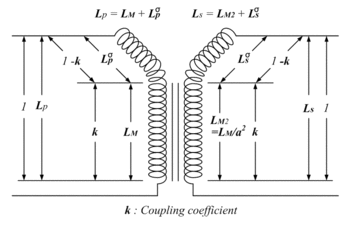
The magnetic circuit's flux that does not interlink both windings is the leakage flux corresponding to primary leakage inductance LPσ and secondary leakage inductance LSσ. These leakage inductances are defined in terms of transformer winding open-circuit inductances as well as the transformer's coupling coefficient or coupling factor k,[4][5] the primary open-circuit self-inductance being given by
- ------ (Eq. 1.1)
where
and
- = Primary inductance
- = Primary self-inductance
- = Primary leakage inductance
- = Magnetizing inductance referred to the primary
Basic transformer inductance measurements
Transformer self-inductances & and mutual inductance M are, in additive and subtractive series connection of the two windings, given by,
- in additive connection, , and,
- in subtractive connection,
- .
The Campbell bridge circuit can also be used to determine transformer self-inductances and mutual inductance using a variable standard mutual inductor pair for one of the bridge sides.[8][9]
Approximate leakage inductances can be obtained by creating a low-impedance short-circuit across each of the respective windings.[10]
It therefore follows that the transformer secondary open-circuit self, magnetizing and leakage inductances are given by
- ------ (Eq. 1.2)
Inductive coupling factor k is given as
- , with 0 < k < 1 ------ (Eq. 1.3)
where
and
- = Secondary inductance
- = Secondary short-circuited inductance
- = Secondary self-inductance
- = Secondary leakage inductance
- = Magnetizing inductance referred to the secondary
The electric validity of the above transformer diagram depends strictly on open circuit conditions for the respective winding inductances considered, more generalized circuit conditions being as developed in the next two sections.
Inductive leakage factor and inductance
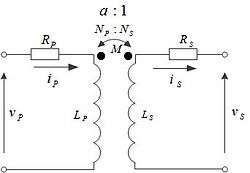

A real linear two-winding transformer can be represented by two mutual inductance coupled circuit loops linking the transformer's five impedance constants as shown in the diagram at right, where,[4][11][12][13]
- M is mutual inductance
- LP & LS are primary and secondary winding self-inductances
- RP & RS are primary and secondary winding resistances
- Constants M, LP, LS, RP & RS are measurable at the transformer's terminals
- Coupling factor k is given as absolute value of coupling coefficient
- , with 0 < k < 1 ------ (Eq. 2.1)
- Winding turns ratio a is in practice given as
- ------ (Eq. 2.2).[14]
The nonideal transformer's mesh equations can be expressed by the following voltage and flux linkage equations,[15]
- ------ (Eq. 2.3)
- ------ (Eq. 2.4)
- ------ (Eq. 2.5)
- ------ (Eq. 2.6),
- where
- ψ is flux linkage
- dψ/dt is derivative of flux linkage with respect to time.
These equations can be developed to show that, neglecting associated winding resistances, the ratio of a winding circuit's inductances and currents with the other winding short circuited and at no-load is as follows,[16]
- ------ (Eq. 2.7),
where,
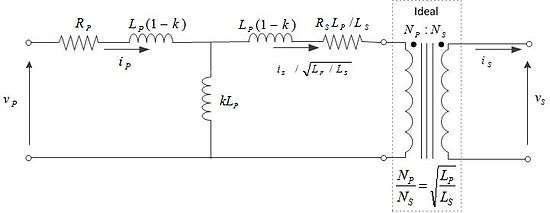
The transformer can thus be further defined in terms of the three inductance constants as follows,[20][21]
- ------ (Eq. 2.8)
- ,
where,
- LM is magnetizing inductance, corresponding to magnetizing reactance XM
- LPσ & LSσ are primary & secondary leakage inductances, corresponding to primary & secondary leakage reactances XPσ & XSσ.
The transformer can be expressed more conveniently as the first shown equivalent circuit with secondary constants referred (i.e., with prime superscript notation) to the primary,[20][21]
- .
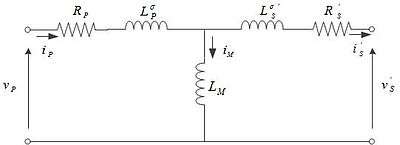
Since
- ------ (Eq. 2.9)
and
- ------ (Eq. 2.10),
we have
- ------ (Eq. 2.11),
which allows expression as second shown equivalent circuit with winding leakage and magnetizing inductance constants as follows,[21]
- ------ (Eq. 2.12)
- ------ (Eq. 2.13).
The nonideal transformer can be simplified as shown in third equivalent circuit, with secondary constants referred to the primary and without ideal transformer isolation, where,
- iM = iP - iS' ------ (Eq. 2.14)
- iM is magnetizing current excited by flux ΦM that links both primary and secondary windings.
- iS' is the secondary current referred to the primary side of the transformer.
Refined inductive leakage factor derivation
a. Per Eq. 2.1 & IEC IEV 131-12-41 inductive coupling factor k is given by
- --------------------- (Eq. 2.1)
b. Per Eq. 2.7 & IEC IEV 131-12-42 Inductive leakage factor is given by
- ------ (Eq. 2.7) & (Eq. 3.7a)
c. multiplied by gives
- ----------------- (Eq. 3.7b)
d. Per Eq. 2-8 & knowing that
- ---------------------- (Eq. 3.7c)
e. multiplied by gives
- ------------------ (Eq. 3.7d)
f. Per Eq. 2.14. Eq. 3.1, Eq. 3.2, Eq. 3.5 & Eq. 3.6
- --- (Eq.3.7e)
All equations in this article assume steady-state constant-frequency waveform conditions the k & values of which are dimensionless, fixed, finite & positive but less than 1.
Refined inductive leakage factor
Referring to the flux diagram below at left, primary driven and the secondary open-circuited, the following equation holds:[22]
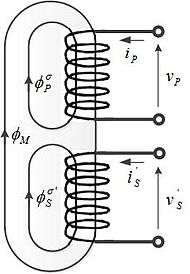
- σP = ΦPσ/ΦM = LPσ/LM ------ (Eq. 3.1)
In the same way,
- σS = ΦSσ'/ΦM = LSσ'/LM ------ (Eq. 3.2)
And therefore,
- ΦP = ΦM + ΦPσ = ΦM + σPΦM = (1 + σP)ΦM ------ (Eq. 3.3)
- ΦS' = ΦM + ΦSσ' = ΦM + σSΦM = (1 + σS)ΦM ------ (Eq. 3.4)
- LP = LM + LPσ = LM + σPLM = (1 + σP)LM ------ (Eq. 3.5)
- LS' = LM + LSσ' = LM + σSLM = (1 + σS)LM ------ (Eq. 3.6),
where
- σP is primary inductive leakage factor
- σS is secondary inductive leakage factor
- ΦM is mutual flux (main flux) / LM is magnetizing inductance
- ΦPσ is primary leakage flux / LPσ is primary leakage inductance
- ΦSσ is secondary leakage flux / LSσ is secondary leakage inductance
The leakage ratio σ can thus be refined in terms of the interrelationship of above winding-specific inductance and Inductive leakage factor equations as follows:[23]
- ------ (Eq. 3.7).
Leakage inductance in practice
Leakage inductance can be an undesirable property, as it causes the voltage to change with loading.
In many cases it is useful. Leakage inductance has the useful effect of limiting the current flows in a transformer (and load) without itself dissipating power (excepting the usual non-ideal transformer losses). Transformers are generally designed to have a specific value of leakage inductance such that the leakage reactance created by this inductance is a specific value at the desired frequency of operation.

Commercial transformers are usually designed with a short-circuit leakage reactance impedance of between 3% and 10%. If the load is resistive and the leakage reactance is small (<10%) the output voltage will not drop by more than 0.5% at full load, ignoring other resistances and losses.
High leakage reactance transformers are used for some negative resistance applications, such as neon signs, where a voltage amplification (transformer action) is required as well as current limiting. In this case the leakage reactance is usually 100% of full load impedance, so even if the transformer is shorted out it will not be damaged. Without the leakage inductance, the negative resistance characteristic of these gas discharge lamps would cause them to conduct excessive current and be destroyed.
Transformers with variable leakage inductance are used to control the current in arc welding sets. In these cases, the leakage inductance limits the current flow to the desired magnitude.
Measurement of inductive coupling factor
The inductive coupling factor is derived from the inductance value measured across one winding with the other winding short-circuited according to the following:[10][24][25]
- Per Eq. 2.7,
- and .
- Therefore, the inductive coupling factor is given by
- . ------ (Eq. 4.1)
See also
- Blocked rotor test
- Circle diagram
- Open circuit test
- Short-circuit inductance
- Short circuit test
- Steinmetz equivalent circuit
External links
IEC Electropedia links:
References
- ↑ Irwin 1997, p. 362.
- ↑ Pyrhönen, Jokinen & Hrabovcová 2008, Chapter 4 Flux Leakage
- ↑ International Electrotechnical Commission: The work of the IEC "is done by some 10,000 electrical and electronics experts from industry, government, academia, test labs and others with an interest in the subject." The IEC's Electropedia is the "World's Online Electrotechnical Vocabulary."
- 1 2 Brenner & Javid 1959, §18-1 Mutual Inductance, pp. 587-591
- ↑ IEC 60050 (Publication date: 1990-10). Section 131-12: Circuit theory / Circuit elements and their characteristics, IEV 131-12-41 Inductive coupling factor
- ↑ Brenner & Javid 1959, pp. 591-259, Fig. 18-6
- ↑ Harris 1952, p. 723, fig. 43
- ↑ Harris 1952, p. 723, fig. 42
- ↑ Khurana 2015, p. 254, fig. 7.33
- 1 2 Voltech, Measuring Leakage Inductance
- ↑ Brenner & Javid 1959, §18-5 The Linear Transformer, pp. 595-596
- ↑ Hameyer 2001, p. 24
- ↑ Singh 2016, Mutual Inductance
- ↑ Brenner & Javid 1959, §18-6 The Ideal Transformer, pp. 597-600: Note that Eq. 2.2 holds exactly for an ideal transformer where, at the limit, as self-inductances approach infinite ( LP → ∞ & LS → ∞ ), the ratio LP/LS approaches a finite value.
- ↑ Hameyer 2001, p. 24, eq. 3-1 thru eq. 3-4
- ↑ Hameyer 2001, p. 25, eq. 3-13
- ↑ {{harvnb|Knowlton|1949|p=§8-67, p. 802: The total flux which passes through the yoke and enters the pole = Φm = Φa + Φe and the ratio Φm/Φa is called the leakage factor and is greater than 1. This factor is different from the inductive leakage factor.
- ↑ IEC 60050 (Publication date: 1990-10). Section 131-12: Circuit theory / Circuit elements and their characteristics, IEV ref. 131-12-42: "Inductive leakage factor }}
- ↑ IEC 60050 (Publication date: 1990-10). Section 221-04: Magnetic bodies, IEV ref. 221-04-12: "Magnetic leakage factor - the ratio of the total magnetic flux to the useful magnetic flux of a magnetic circuit." This factor is also different from the inductive leakage factor.
- 1 2 Hameyer 2001, p. 27
- 1 2 3 Brenner & Javid 1959, §18-7 Equivalent Circuit for the nonideal transformer, pp. 600-602 & fig. 18-18
- ↑ Hameyer 2001, pp. 28-29, eq. 3-31 thru eq. 3-36
- ↑ Hameyer 2001, p. 29, eq. 3-37
- ↑ Rhombus Industries, Testing Inductance
- ↑ This measured short-circuit inductance value is often referred to as the leakage inductance, but it is an informal term. As concrete examples are, Measuring Leakage Inductance,Testing Inductance. The formal leakage inductance is given by (Eq. 2.12).
Bibliography
- Brenner, Egon; Javid, Mansour (1959). "Chapter 18 - Circuits with Magnetic Coupling". Analysis of Electric Circuits. McGraw-Hill. pp. esp. 586–617.
- U. of Colorado - Magnetics. "Part III. Magnetics - Chapter 12: Basic Magnetics Theory" (PDF). Fundamentals of Power Electronics. University of Colorado. pp. 72 slides, see esp. slides 1 to 33.
- Didenko, V.; Sirotin, D. (2012). "Accurate Measurement of Resistance and Inductance of Transformer Windings" (PDF). XX IMEKO World Congress - Metrology for Green Growth. Busan, Republic of Korea, September 9−14, 2012.
- Dixon, Lloyd (2001). "Power Transformer Design" (PDF). Magnetics Design Handbook. Texas Instruments. pp. 4–1 to 4–12.
- Hameyer, Kay (2001). "§3 Transformer". Electrical Machines I: Basics, Design, Function, Operation. RWTH Aachen University Institute of Electrical Machines. pp. 23–52.
- Harris, Forest K. (1952). Electrical Measurements (5th printing (1962) ed.). New York, London: John Wiley & Sons.
- Heyland, A. (1894). "A Graphical Method for the Prediction of Power Transformers and Polyphase Motors". ETZ. pp. 561–564.
- Heyland, A. (1906). A Graphical Treatment of the Induction Motor. Translated by George Herbert Rowe; Rudolf Emil Hellmund. McGraw-Hill. pp. 48 pages.
- "Electropedia: The World's Online Electrotechnical Vocabulary". IEC 60050 (Publication date: 1990-10). Archived from the original on 2015-04-27.
- Irwin, J. D. (1997). The Industrial Electronics Handbook. A CRC handbook. Taylor & Francis. ISBN 9780849383434. Retrieved 2014-01-14.
- Khurana, Rohit (2015). Electronic Instrumentation and Measurement. Vikas Publishing House.
- Knowlton, A.E. (Ed.) (1949). Standard Handbook for Electrical Engineers (8th ed.). McGraw-Hill. p. 802, §8–67: The Leakage Factor.
- MIT-Press (1977). "Self- and Mutual Inductances". Magnetic circuits and transformers a first course for power and communication engineers. Cambridge, Mass.: MIT-Press. pp. 433–466. ISBN 9780262310826.
- Pyrhönen, J.; Jokinen, T.; Hrabovcová, V. (2008). Design of Rotating Electrical Machines. p. Chapter 4 Flux Leakage.
- Rhombus Industries. Testing Inductance (PDF).
- Singh, Mahendra (2016). "Mutual Inductance". Electronics Tutorials. Retrieved 6 January 2017.
- Voltech. Measuring Leakage Inductance (PDF).